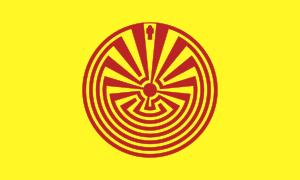I'itoi facts for kids
Iʼitoi or Iʼithi is a very important figure in the stories of the O'odham people. They live in Arizona, USA. I'itoi is seen as a clever creator god. He lives in a cave under Baboquivari Mountain. This mountain is a special, sacred place for the Tohono O'odham Nation.
O'odham stories say that I'itoi brought the Hohokam people to this world from an underground place. The Hohokam were ancestors of both the Tohono O'odham (Desert People) and the Akimel O'odham (River People). I'itoi also gave the O'odham people the Himdag. This is a set of rules that helps people live in balance with the world.
People who visit I'itoi's cave are asked to bring a gift. This is to help them return safely from the cave's deep parts.
Contents
Who is I'itoi?
The Pima people also call I'itoi Se:he, which means "Elder Brother." Another name, Iʼithi, is used by the Hia C-eḍ O'odham.
I'itoi is often known as the Man in the Maze. This name comes from a special design. You can see this design on O'odham basketry and ancient rock carvings called petroglyphs. The design shows a person at the start of a labyrinth or maze. The Akimel O'odham and Tohono O'odham people believe this maze is like the journey of life. As a person travels through it, they meet different things that change them.
The Man in the Maze Symbol
The Man in the Maze design is very popular today. You can find it in art and crafts from the Southwest United States. Tohono O'odham silversmiths use it on rings and other jewelry. Akimel O'odham artists use it on their baskets. This pattern has been popular since the 1900s.
Every basket with this pattern has a small "mistake" in its design. It's called a dau, which means "door." This "mistake" is put there on purpose. It lets the spirit of the basket be released.
The Man in the Maze symbol has also appeared in popular TV shows. In the show "Westworld," it was described as an "old native myth." It represented "the sum of a man's life." This included the choices he makes and the dreams he holds onto. In the TV series "Fringe," the symbol was on a bracelet. It was explained that the maze shows "the journey of life, the obstacles, making the right choices." It also means finding your way "home, a place to belong."
I'itoi's Ancient Story
In the late 1930s, Tohono O'odham storytellers shared a legend with Ruth Murray Underhill. She wrote it down in her book, Singing For Power.
How the World Began
The story says that Earth-maker created the world. He used dirt and sweat from his own skin. The flat earth and the sky came together with a loud crash. From this, I'itoi was born. He was the protector of the Papagos (another name for the O'odham). He had light hair and a beard.
I'itoi and Earth-maker shaped the new world and filled it with people. Coyote also appeared, uncreated, and was always curious.
The Great Flood
There was a big flood in this new world. Earth-maker, I'itoi, and Coyote agreed to take shelter. They decided that whoever came out first after the flood would be their leader. Earth-maker came out first, then I'itoi. But I'itoi insisted on being called "Elder Brother" and took the title.
I'itoi "brought the people up like children." He taught them many skills and arts. But over time, he became unkind. So, the people killed him.
I'itoi Returns
Even though he was killed, I'itoi had so much power that he came back to life. After that, he created war. He decided to clear the earth of the people he had made. To do this, he needed an army. He went underground and brought up the Papagos.
The O'odham people live in a land with many old ruins. These ruins belonged to the Hohokam, "the people who are gone." I'itoi drove them, some to the north and some to the south.
I'itoi "had a song for everything." While his men fought, I'itoi helped them by singing. His songs made the enemies blind and helpless. Now, I'itoi has left the world. He lives as a small old man in a mountain cave. Or, perhaps, he has gone back underground.
The Maze: A Life Journey
According to O'odham oral history, the labyrinth design shows the choices and experiences people have during their lives. When you reach the middle of the "maze," you find your dreams and goals.
At the very center, there is one last turn. This is your final chance to look back at the choices you made and the path you took. After this, the Sun God greets you, blesses you, and helps you move into the next world.
Alfretta Antone shared her understanding of the maze: Elder Brother lived in the maze. He was like a magician or a medicine man. He could disappear and heal people. He lived there because he had many enemies. He made the maze so people couldn't find him. They would go in but then turn around and leave.
In real life, the maze is like your journey. You start at the top and go into the maze. You might fall or feel sad. But you pick yourself up and keep going. There are many places in the maze where you might stop. Maybe a loved one died, and you feel bad. But you get up, turn around, and go again.
When you reach the middle of the maze, that's when you see the Sun God. The Sun God blesses you and says you have made it. That's where you pass on. The maze is a symbol of life. It shows happiness, sadness, and reaching your goals. Your dream is in the middle of the maze. That's what my grandparents told me about the maze.


